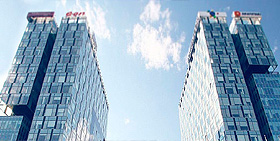For the first time after 10 years, the decreasing of insolvencies is accompanied

Coface upgraded the Romanian’s rank level to A4, risk class indicating that the economic and financial outlook could be marked by some weakness. The political context suffers from tensions, and the business climate still presents significant shortcomings. The average probability of company default is reasonable. In this context, we notice, for the first time in the last eight years, a decreasing effect in the economy caused by insolvencies.
Although the number of insolvent companies has declined significantly in 2014 (-28%), in 2015 (-50%) and in the first half of 2016 (-25%), the economic impact has been relatively constant, while the financial losses ranged from 13 to 14 MRON and the social impact, i.e. the unemployment number, varied between 80,000 and 90,000. Decreasing insolvencies in the 2014 - 2015 was not related to a beneficial effect in the economy, while the number of large insolvent companies has been high.
Instead, a 25% decrease of newly opened insolvencies in the first half of this year compared to the same last period is correlated with a decrease of the negative domino effect propagated in the economy, because financial losses decreased by 56% and the lost jobs by 12%.
Decrease in insolvencies in the first semester of 2016 compared to first semester of 2015
From Coface analysis, based on data provided by the Bulletin of Insolvency Proceedings (BPI) indicates that the first half of 2016, 4,291 insolvencies procedures registered, a decrease of about 25% over the same period of 2015, 5,759 insolvencies opened. According to Coface estimates, the total number of insolvencies newly opened this year will be about 7,800, 55% less than the average of the last 10 years.
Considering the continuing decline of insolvencies newly opened during the past three years, the level estimated for the year is lower than 2015. In addition, the number of insolvencies opened in the first half of 2016 among companies with a turnover of over 1 MEUR registers an important decrease, respectively 229 companies, compared to 309, in the same period of the previous year.
Effects on the payment behaviour
The decrease of the negative spillover effect in the economic environment could be observed in the dynamic of the general payment behaviour. The value of the rejected payment instruments in the first five months of 2016 was 1.5BRON, 71% less than the previous year, but similar to the same period of 2008.
Moreover, the number of the rejected payment instruments decreased by 21% in the first half of 2016 compared to 2015, from 148 K RON to 53 K RON.
Romania and the dynamics of the insolvencies in similar CEE countries
Analysing the insolvencies compared to similar CEE countries, Romania still has a very high incidence of insolvencies reported to the number of active companies. Although it has a share of about 7% in the total active companies in the CEE region, Romania generated about 22% of regional insolvencies in 2015. The insolvency ratio of 23 to 1,000 active Romanian companies is about three times higher than the regional average.
The comparison with Poland (the most sustainable model in this respect) is eloquent because Poland has almost four times more active companies than Romania, but less than 1,000 insolvent companies in each of the last ten years. This shows that the number of insolvent Romanian companies in one year is almost equal to the total insolvencies opened in Poland in ten years.
In the future, the key challenge for the business environment will be the following:
- Continuing the positive trend on improving the payment discipline. The positive development in the first half of 2016 should continue, given the average ratio of the region.
- Romania is a country with a large population, but very few companies amid the low entrepreneurial spirit, a high corruption and a high migration effect, which increasingly affects the qualified workforce. Romania registers 2% rate of entrepreneurship, with only 23 active companies per 1,000 inhabitants, while the regional average is 57.
The most sustainable model in this respect is the Czech Republic, with 137 active companies per 1,000 inhabitants; although the Czech Republic has a two times smaller population than Romania, it has almost three times more active companies;
- The private sector still suffers from a high rate of active companieswho interrupt their activity. Although the number of insolvencies newly opened decreases in January-May 2016 by 23%, the number of dissolved companies increases by 52% and of the suspended companies by 9%. The number of companies who interrupt their activity in the first five month of 2016 increases by 47% compared to the same period of the previous year, 63% higher than newly registered companies.
“Unlike the 2010-2015 insolvencies, when one of the main causes was the indebtedness caused by accumulated losses and the inefficient uses of assets, the insolvent companies in the first half of 2016 recorded a steady decline in indebtedness. Collecting increasingly slower debts is one of the major issues of the insolvent companies.The companies who interrupt their activity in the first half of the year registered almost a tripling of the average debt collection. In addition, it’s for the first time in eight years that insolvencies contraction accompanied a decrease of the financial and social impact, as well as a decreases in payment instruments rejected nationally”, Iancu Guda, Senior Economist Coface Romania, stated.
Contact
Diana OROS
Marketing and Communications Specialist
42 Pipera St., 6th Floor - 020112
District 2 - Bucharest
ROMANIA
T: +40 37 467 08 86
Email: diana.oros@coface.com



